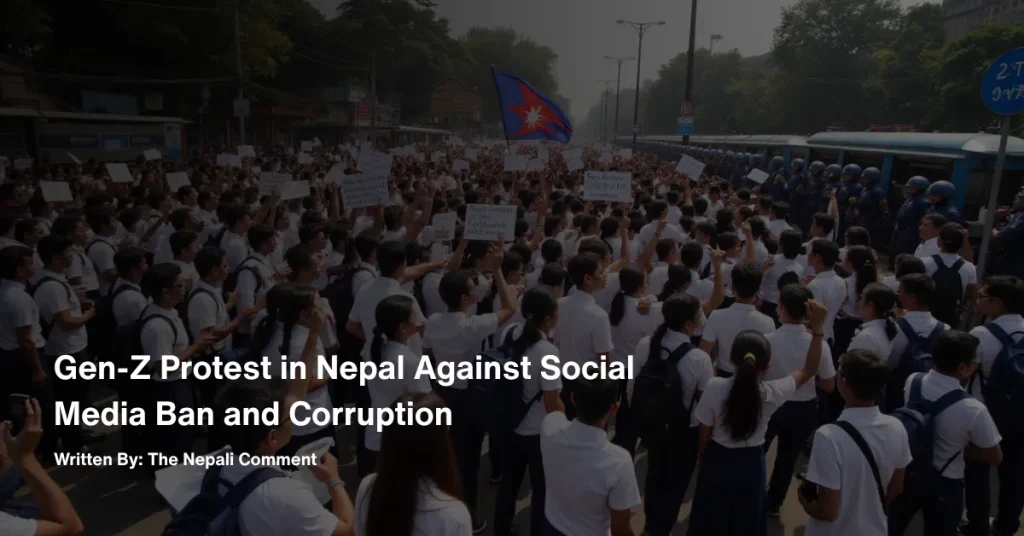Introduction: A Digital Generation Takes to the Streets
On September 8, 2025, Nepal witnessed a historic mobilization as thousands of Gen Z activists (born between 1997–2012) took to the streets of Kathmandu and other cities. The protests were triggered by the government’s ban on 26 social media platforms and fueled by growing frustration over corruption, political privilege, and economic stagnation.
Organized independently of political parties, the youth-led protest represents a defining moment in Nepal’s democratic journey. The movement centered at Maitighar Mandala and New Baneshwor, symbolizing a generational awakening demanding digital freedom, transparency, and opportunities.
1. The Social Media Ban and Its Fallout
1.1 The Ban: September 4, 2025
The government blocked 26 platforms including Facebook, Instagram, YouTube, WhatsApp, LinkedIn, Reddit, and X (formerly Twitter). The action came under the Directive for Regulating the Use of Social Media, 2080, requiring platforms to:
- Register with the Ministry of Communications and IT
- Establish local offices
- Appoint grievance officers
- Implement content moderation systems
Only TikTok, Viber, Nimbuzz, Popo Live, WeTalk, Global Diary, and Hamro Patro complied. Others were inaccessible from September 4 onward.
1.2 Immediate Consequences
- Economic Collapse: Small businesses and freelancers lost revenue streams overnight. Content creators and home entrepreneurs relying on Facebook and Instagram faced sudden shutdowns.
- Educational Setback: Students lost access to learning resources like YouTube tutorials, GitHub repositories, and Reddit forums.
- Communication Breakdown: Tourism, hospitality, and manpower agencies lost easy contact with clients abroad, falling back on outdated emails and costly calls.
- Public Resistance: Google Trends recorded a 400% surge in VPN searches as citizens tried to bypass the restrictions, despite police warnings about security risks.
2. From Outrage to Mobilization
2.1 TikTok as the Rallying Tool
With TikTok one of the few platforms left operational, it became the epicenter of mobilization. Videos exposing the lavish lifestyles of politicians’ children contrasted sharply with youth unemployment and daily struggles. Hashtags like #WakeUpGenZ, #NepalProtest, and #RestoreOurInternet trended nationwide.
2.2 Organizers’ Strategy
- Dress Code: School uniforms to highlight the youth-led identity
- Age Limit: Only under-28s allowed to participate, keeping the movement apolitical
- Demands:
- Lift the social media ban
- End corruption and political privilege
- Improve governance and job creation
- Recognize digital rights as fundamental rights
3. Pre-Protest Developments (September 7, 2025)
3.1 Gathering Points Announced
- Maitighar Mandala: 11 a.m. main rally
- New Baneshwor: 9 a.m. near the Parliament building
- Nationwide: Similar gatherings in Pokhara, Biratnagar, Butwal, and other cities
3.2 Key Endorsements
- Mayor Balen Shah: Expressed support, calling it a “spontaneous movement of Gen Z,” though he said he would not attend due to the age limit.
- Durga Prasai: Pledged personal participation while warning the government against violence like the March 28, 2025 crackdown, when two people died and hundreds were injured.
- Rastriya Swatantra Party: Declared the ban “tyranny,” linking it to the jailing of party president Rabi Lamichhane.
3.3 Security Preparations
Authorities confirmed large police deployments across Kathmandu. Assistant CDO Muktiram Rijal said the goal was to ensure peaceful assembly, but past events cast doubt. On March 28, Nepal Police fired 746 tear gas shells, 198 blank rounds, and two live bullets during unrest, leaving deep scars.
4. September 8, 2025: Protest Day
The Scene in Kathmandu
By morning, thousands of youth in school uniforms converged at Maitighar Mandala and New Baneshwor. Chants demanding freedom of expression, better governance, and an end to corruption echoed across the capital. Roads were blocked, traffic diverted, and security forces on alert.
Live Updates (Morning to Noon)
- 9:00 a.m. – Students began gathering near the Parliament building in Baneshwor.
- 10:30 a.m. – Security forces set up barricades, while organizers urged participants to remain peaceful.
- 11:00 a.m. – Maitighar Mandala flooded with protesters, TikTok livestreams carrying the event globally despite the ban.
5. Public Sentiment and Global Attention
- Citizens described the ban as “dictatorship in democratic disguise.”
- VPN usage surged despite cybersecurity warnings.
- International groups like the Committee to Protect Journalists (CPJ) condemned the ban, calling it a dangerous precedent for press freedom.
- Global media compared the movement to Hong Kong, Thailand, and Myanmar, where youth-led protests challenged state repression.
6. The Road Ahead
Short-Term
The government faces rising pressure to review the ban but may resort to surveillance or arrests. Organizers fear a repeat of March’s crackdown.
Long-Term
- Digital Rights Debate: Could push Nepal toward either restoring freedoms or creating a “Great Firewall” model.
- Political Shift: Gen Z activism may grow into a sustained force reshaping governance, transparency, and accountability.
Conclusion: A Defining Moment
The September 8 protest is more than resistance to a social media ban—it reflects a generational demand for freedom, fairness, and a future worth staying in Nepal for. With international eyes on Kathmandu, the choices made by both the government and the youth today will shape the country’s democratic path for years to come.
Mayor Balen Shah’s words to Gen Z remain central: “What kind of country do you wish to see?”

